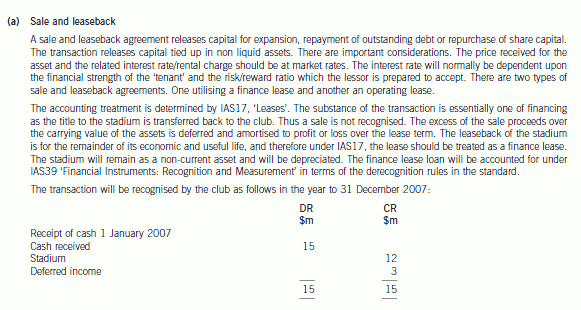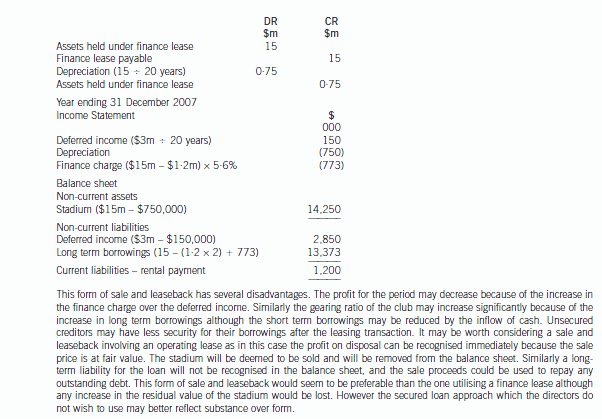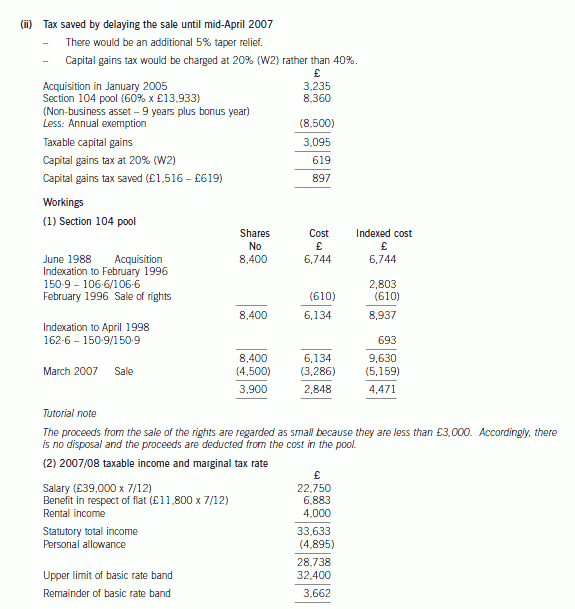过来了解一下,ACCA持证人薪资待遇如何?
发布时间:2020-05-16
大家最关心的就是ACCA考试考过之后,薪资待遇如何,这个也是很多人想要报考ACCA的原因,那就来看看下面的内容吧。
一、ACCA薪资待遇一览
根据国际证书ACCA的调查,ACCA会员的年薪主要在10万至80万之间,远高于一般市场上的财务人员的收入。国际证书会员中26岁-30岁的会员中主要薪资范围集中在10万-30万,起薪都在5万以上;ACCA年薪有30-50万以上的肯定还是有一定要达到一定的工作年限的,当然说不准也要看个人的机遇了。
先来说四大,对于一个刚本科的应届生起薪平均在7000左右,硕士会比本科多1000左右的薪水,如果你持有ACCA证书的话。那么每月会有Qpay补贴1000元,四大对员工的职业发展都有很清晰的路线,工作的第三年基本可以成为助理审计经理,年薪大概在15W左右,五年可以成为审计经理,10年以上成为合伙人。
ACCA学员及会员也可以去国内国际金融机构的投资、分析、风险、财务、审计等部门,应届毕业生的起薪在7000左右,如果你是从四大工作2-3年跳槽出来进入这些企业,那么你就是香饽饽,薪水的大致能达到25W左右甚至更高。
二、薪资待遇为什么高?
持有ACCA证书的准会员在世界五百强或者知名企业比如华为、BAT的刚毕业薪水也在7000左右,成为经理的年薪大致在30W左右,还有年终奖哦,当然如果你成为CFO或者合伙人,工资只是一部分,企业的年终营收分红才是最大的收益。
目前ACCA人才市场需求量大,且薪资水平非常可观。据ACCA年度薪资调查报告显示,从年薪分布来看,30万以上各收入区间,ACCA会员收入优势明显,所占比例远远高于准会员与学员。
以上就是全部的考试内容了,看完之后对你考试的复习有帮助吗,大家是不是知道了ACCA考试的薪资待遇之后更加有复习的动力了呢,加油吧。
下面小编为大家准备了 ACCA考试 的相关考题,供大家学习参考。
3 Seejoy is a famous football club but has significant cash flow problems. The directors and shareholders wish to take
steps to improve the club’s financial position. The following proposals had been drafted in an attempt to improve the
cash flow of the club. However, the directors need advice upon their implications.
(a) Sale and leaseback of football stadium (excluding the land element)
The football stadium is currently accounted for using the cost model in IAS16, ‘Property, Plant, and Equipment’.
The carrying value of the stadium will be $12 million at 31 December 2006. The stadium will have a remaining
life of 20 years at 31 December 2006, and the club uses straight line depreciation. It is proposed to sell the
stadium to a third party institution on 1 January 2007 and lease it back under a 20 year finance lease. The sale
price and fair value are $15 million which is the present value of the minimum lease payments. The agreement
transfers the title of the stadium back to the football club at the end of the lease at nil cost. The rental is
$1·2 million per annum in advance commencing on 1 January 2007. The directors do not wish to treat this
transaction as the raising of a secured loan. The implicit interest rate on the finance in the lease is 5·6%.
(9 marks)
Required:
Discuss how the above proposals would be dealt with in the financial statements of Seejoy for the year ending
31 December 2007, setting out their accounting treatment and appropriateness in helping the football club’s
cash flow problems.
(Candidates do not need knowledge of the football finance sector to answer this question.)


(ii) Advise Benny of the amount of tax he could save by delaying the sale of the shares by 30 days. For the
purposes of this part, you may assume that the benefit in respect of the furnished flat is £11,800 per
year. (3 marks)

(c) At 1 June 2006, Router held a 25% shareholding in a film distribution company, Wireless, a public limited
company. On 1 January 2007, Router sold a 15% holding in Wireless thus reducing its investment to a 10%
holding. Router no longer exercises significant influence over Wireless. Before the sale of the shares the net asset
value of Wireless on 1 January 2007 was $200 million and goodwill relating to the acquisition of Wireless was
$5 million. Router received $40 million for its sale of the 15% holding in Wireless. At 1 January 2007, the fair
value of the remaining investment in Wireless was $23 million and at 31 May 2007 the fair value was
$26 million. (6 marks)
Required:
Discuss how the above items should be dealt with in the group financial statements of Router for the year ended
31 May 2007.Required:
Discuss how the above items should be dealt with in the group financial statements of Router for the year ended
31 May 2007.
(c) The investment in Wireless is currently accounted for using the equity method of accounting under IAS28 ‘Investments in
Associates’. On the sale of a 15% holding, the investment in Wireless will be accounted for in accordance with IAS39. Router
should recognise a gain on the sale of the holding in Wireless of $7 million (Working 1). The gain comprises the following:
(i) the difference between the sale proceeds and the proportion of the net assets sold and
(ii) the goodwill disposed of.
The total gain is shown in the income statement.
The remaining 10 per cent investment will be classified as an ‘available for sale’ financial asset or at ‘fair value through profit
or loss’ financial asset. Changes in fair value for these categories are reported in equity or in the income statement respectively.
At 1 January 2007, the investment will be recorded at fair value and a gain of $1 million $(23 – 22) recorded. At 31 May
2007 a further gain of $(26 – 23) million, i.e. $3 million will be recorded. In order for the investment to be categorised as
at fair value through profit or loss, certain conditions have to be fulfilled. An entity may use this designation when doing so
results in more relevant information by eliminating or significantly reducing a measurement or recognition inconsistency (an
‘accounting mismatch’) or where a group of financial assets and/or financial liabilities is managed and its performance is
evaluated on a fair value basis, in accordance with a documented risk management or investment strategy, and information
about the assets and/ or liabilities is provided internally to the entity’s key management personnel.
(ii) the factors that should be considered in the design of a reward scheme for BGL; (7 marks)
(ii) The factors that should be considered in the design of a reward scheme for BGL.
– Whether performance targets should be set with regard to results or effort. It is more difficult to set targets for
administrative and support staff since in many instances the results of their efforts are not easily quantifiable. For
example, sales administrators will improve levels of customer satisfaction but quantifying this is extremely difficult.
– Whether rewards should be monetary or non-monetary. Money means different things to different people. In many
instances people will prefer increased job security which results from improved organisational performance and
adopt a longer term-perspective. Thus the attractiveness of employee share option schemes will appeal to such
individuals. Well designed schemes will correlate the prosperity of the organisation with that of the individuals it
employs.
– Whether the reward promise should be implicit or explicit. Explicit reward promises are easy to understand but in
many respects management will have their hands tied. Implicit reward promises such as the ‘promise’ of promotion
for good performance is also problematic since not all organisations are large enough to offer a structured career
progression. Thus in situations where not everyone can be promoted there needs to be a range of alternative reward
systems in place to acknowledge good performance and encourage commitment from the workforce.
– The size and time span of the reward. This can be difficult to determine especially in businesses such as BGL
which are subject to seasonal variations. i.e. summerhouses will invariably be purchased prior to the summer
season! Hence activity levels may vary and there remains the potential problem of assessing performance when
an organisation operates with surplus capacity.
– Whether the reward should be individual or group based. This is potentially problematic for BGL since the assembly
operatives comprise some individuals who are responsible for their own output and others who work in groups.
Similarly with regard to the sales force then the setting of individual performance targets is problematic since sales
territories will vary in terms of geographical spread and customer concentration.
– Whether the reward scheme should involve equity participation? Such schemes invariably appeal to directors and
senior managers but should arguably be open to all individuals if ‘perceptions of inequity’ are to be avoided.
– Tax considerations need to be taken into account when designing a reward scheme.
声明:本文内容由互联网用户自发贡献自行上传,本网站不拥有所有权,未作人工编辑处理,也不承担相关法律责任。如果您发现有涉嫌版权的内容,欢迎发送邮件至:contact@51tk.com 进行举报,并提供相关证据,工作人员会在5个工作日内联系你,一经查实,本站将立刻删除涉嫌侵权内容。
- 2020-01-09
- 2020-04-25
- 2020-01-10
- 2020-04-09
- 2020-01-09
- 2021-06-25
- 2020-03-27
- 2020-03-25
- 2020-04-08
- 2020-04-22
- 2020-01-09
- 2020-04-20
- 2020-01-10
- 2020-05-02
- 2020-04-18
- 2020-01-14
- 2020-01-10
- 2020-01-10
- 2020-04-09
- 2020-04-24
- 2021-06-26
- 2020-03-27
- 2020-01-10
- 2020-04-11
- 2020-01-10
- 2020-01-09
- 2020-02-18
- 2020-03-13
- 2020-08-14
- 2019-12-28